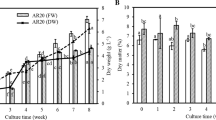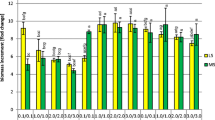Abstract
We have established cell-suspension cultures of mountain ginseng (Panax ginseng G A. Mayer), and have attempted to increase the yield of saponin by manipulating our processing method and culturing factors (e.g., media strengths; the presence of plant growth regulators or sucrose; ratios of NO+ 3/ NH- 4). Maximum biomass yield was obtained in media containing 2,4-D. However, saponin productivity was much higher in a medium comprising either IBA or NAA; 7.0 mg/L IBA was optimal for promoting both cell growth (10.0 g/L dry weight) and saponin production (7.29 mg/g DW total ginsenoside). Although the addition of cytokinins (BA and kinetin) did not affect cell growth, the level of saponin (particularly in the Rb group) was enhanced when the media were supplemented with either 0.5 mg/L BA or 0.5 mg/L kinetin. Half- and full-strength MS media were equally suitable for inducing both biomass as well as saponin production. We also investigated the effect of various concentrations of sucrose and nitrogen, and found that 30 g/L sucrose enhanced biomass yield as well as saponin content However, further increases (i.e., up to 70 g/L) led to a decrease in saponin accumulation and biomass production. Maximum growth and saponin productivity were reported from treatments with an initial nitrogen concentration of 30 mM. In general, the amount of saponin increased when the test media had high NO+ 3/ NH- 4 ratios; in fact, saponin production was greatest when nitrate was the sole nitrogen source.
Similar content being viewed by others
Literature Cited
Akalezi CO, Uu S, Li QS, Yu JT, Zhong JJ (1999) Combined effects of initial sucrose concentration and inoculum size on cell growth and ginseng saponin production by suspension cultures ofPanax ginseng. Pro Biochem34: 639–642
Bourgaud F, Gravot A, Milesi S, Gontier E (2001) Production of plant secondary metabolites: A historical perspective. Plant Sci161: 839–851
Choi KT, Ahn lO, Park JC (1994a) Production of ginseng saponin in tissue culture of ginseng (Panax ginseng CA. Mayer). Russ J Plant Physiol40: 784–788
Choi KT, Lee CH, Ahn IO, Lee JH, Park JC (1994b) Characteristics of the growth and ginsenosides in the suspension-culture cells of Korean ginseng (Panax ginseng C. A. Mayer),In WC Bailey, C Whitehead, JTA Proctor, JT Kyle, eds,Proc Intl Ginseng Conf, Vancouver, BC, Canada, pp 259–268
Ding J (1998) Suspension culture of ginseng cells. Acta Plant Physiol1: 76–78
Domenburg H, Knorr D (1995) Strategies for the improvement of secondary metabolite production in plant cell cultures. Enzyme Microb Technol17: 674–684
Furuya, T, Yoshikawa T (1987) Saponin production by cultures ofPanax ginseng transformed with Agrobacterium rhizogenes. Plant Cell Rep6: 449–453
Hibino K, Ushiyama K (1998) Commercial production of ginseng by plant cell culture technology,In TJ Fu, G Singh, WR Curtis, eds, Plant Cell Culture for the Production of Food Ingredients, Proc ACS Symp, San Francisco, CA, USA, Plenum, New York, pp 13–17
Huang KC (1993) The Pharmacology of Chinese Herbs. CRC Press, Boca Raton, FL, USA, pp 21–45
Murashige T, Skoog F (1962) A revised medium for rapid growth and bioassays with tobacco tissue. Physiol Plant15: 473–497
Tabata M, Fujita T (1985) Producing of shikonin by plant cell cultures,In M Zaitlin, P Day, A Hollaender, eds, Biotechnology in Plant Science: Relevance to Agriculture in the Eighties. Academic Press, New York, pp 207–218
Tang W, Eisenbrand G (1992)Panax ginseng C. A. Mayer, Chinese Drugs of Plant Origin. Springer-Verlag, Berlin, pp 710–737
Weselake RJ, Byers SD, Davoren JM, Laroche A, Hodges DM, Pomeroy MK, Fumkawa-Stoffer TL (1998) Tria-cylgtycerol biosynthesis and gene expression in microspore-derived cell suspension cultures of oilseed rape, j Exp Bot49: 33–39
William A, John G, Hendel J (1996) Reversed-phase high-performance liquid Chromatographic determination of ginsenosides of Panaxquinquefolium. J Chromatogr775: 11–17
Wu JY, Zhong JJ (1999) Production of ginseng and its bioactive components in plant cell culture: Current technological and applied aspects. J Biotech68: 89–99
Yu KW, Hahn EJ, Paek KY (2000) Production of adventitious ginseng roots using bioreactors. Kor J Plant Tiss Cult27: 309–315
Zhong JJ, Bai Y, Wang SJ (1996) Effects of plant growth regulators on cell growth and ginsenoside saponin production by suspension cultures ofPanax quinquefolium. J Biotech45: 227–234
Zhong JJ, Wang SJ (1998) Effects of nitrogen source on the production of ginseng saponin and Polysaccharide by cell cultures ofPanax quinquefolium. Pro Biochem33: 671–675
Author information
Authors and Affiliations
Corresponding author
Rights and permissions
About this article
Cite this article
Lian, ML., Chakrabarty, D. & Paek, KY. Effect of plant growth regulators and medium composition on cell growth and saponin production during cell-suspension culture of mountain ginseng (Panax ginseng C. A. mayer). J. Plant Biol. 45, 201–206 (2002). https://doi.org/10.1007/BF03030360
Received:
Accepted:
Issue Date:
DOI: https://doi.org/10.1007/BF03030360




